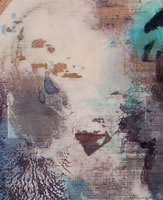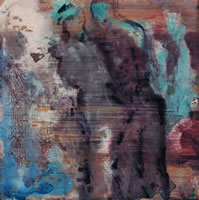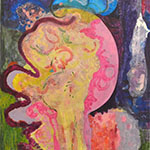
Statement
My father was an art historian, my mother, a sculptor, so art was always part of my environment. This meant that I was introduced to Abstract Expressionism, Pre-historic art, Renaissance Italian and Dutch 17th Century painting at an early age, which still hold interest for me.
When I went to art school, I attended the weekly classes held by the Visionary artist, Cecil Collins. He and Mark Tobey had created a technique that encouraged the abandonment of any conscious control to allow chance and natural expression. I found the simultaneous use of both hands in his process, very useful as it trained both sides of the brain – the left and right to co-operate, creating a harmonious union of the analytical and intuitive.
The way I make my paintings is very influenced by that training. Now I seek to play with the paradigm between figuration and abstraction, coming in and out of focus through rhythm, colour, shape and texture. The work is never fixed, but in a state of flux. If the viewer relaxes their mind, marks and gestures can describe a face, or a profile, animal or creature. The paintings are catalysts that stimulate the subconscious mind to reveal archetypes, and yet, in a different state of mind, different things can appear. The images are not pre-conceived, I get into my rhythm, applying colour and brushstrokes, aiming to express the intuitive and spontaneous, whilst honouring the rich cultural heritage of my background.
The fact that I am also a therapist, with that insight and focus on transformation comes across. For a person is not only physical (figurative and of the surface, the conscious), but also of the abstract (subconscious), so there is a fusion between conscious and sub-conscious. I find that dialogue very engaging as it continuously creates opportunities for exploration and discovery. The Colour and Curve paintings (1994-2006) tried to capture the Sacred Feminine and veered more towards figuration. The Loss series (2006-2007) went further into the subconscious by letting go of having to pin anything down (in a figurative sense) in order to commune with “the other” (whatever that may be). The Manifestation paintings are a continuation of that process.
Biography
Chronology
1997-
Teaching part-time from her studio in London.1982-
Improvisational singing and performance.1988-99
Part-time assistant at the art gallery, England & Co,London.1985-89
Studied with the artist, Cecil Collins.1983-86
Central School of Art and Design, London.1982-83
Wimbledon School of Art, London.1962-
Born London.
Publications
- In Celebration of Cecil Collins: Visionary Artist and Educator, compiled by Nomi Rowe, Tate Publications, 2008
- Colour and Curve, catalogue for solo exhibition exhibition with Benjamin C. Hargreaves at The Air Gallery.
- Vogue Italia (Casa n.6) Dec 2000
- The Dictionary of Artists in Britain Since 1945 by David Buckman.
- London.Group Open, 2009
Reviews
- Time Out by Sarah Kent for DIY, Sept 6-13 2000 No.1568
- Galleries Magazine by Nicholas Usherwood for Colour &Curve, April 2000
- What’s On by John Coleman for DIY,Sept 6-13 2000
- Metro by Claire Allfree for DIY, Aug 24 2000
Collections
- Work held in collections in USA: New York, Houston, Long Island, San Francisco; Australia,
- England and Scotland.
Solo Exhibitions
2000
Colour and Curve, Benjamin C. Hargreaves at The Air Gallery, London.1999
The River and the Figure, Putney Library.1998
Body in Mind, Traditional Acupuncture Centre, London.1996
The River at Putney, Putney Library, London.
Group Exhibitions
2012
Summer Exhibition, The Royal Academy of Arts, London.2012
400 Women, Sugar City, Amsterdam.2011
Birdbrain, collaboration with Catherine Clover, Soundfjord, London; Emerson Galerie, Berlin, Germany2011
and Screenspace, Melbourne, Australia.2011
400 Women, Edinburgh Festival.2010
400 Women, London.2010
Luck of the Draw, Diverse Works, Houston, USA.2010
Skylark in the Park, London.2009
London.Group Open.2008
Six Artists, Karma Gallery, Calcutta, India.2007
Salon Open, D21 Gallery, Leipzig, Germany.2004
Rotunda Gallery, New York, USA May/June Kunsthaus, Zurich.2003
Three Artists at Eastman Gallery, Houston, Texas, USA.2003
Various Art Fairs with Benjamin C Hargreaves2002
Art on Paper Fair, Royal College of Art, London.2002
Watercolour Art Fair, Dorchester Hotel, London.2002
Summer & Christmas Exhibition, Benjamin C. Hargreaves. London.2002
Collyer-Bristow Christmas Exhibition, London2001
Art on Paper Fair, Royal College of Art, London.2001
Multiple Choice, The Spitz Gallery, London.2001
Watercolour Art Fair, Dorchester Hotel, London.2001
Summer & Christmas Exhibition, Benjamin C. Hargreaves. London.2001
The Affordable Art Fair, Battersea, London2000
DIY-19 Variations on the theme of wallpaper, Co-Curated by Alley, made “Critics’ Choice” and top 10 for 2000 in Time Out magazine.2000
Constellation, The House Gallery, London.2000
Summer & Christmas Exhibitions, Benjamin C Hargreaves2000
Various Art Fairs with Benjamin C Hargreaves1999
Estate, Osterley Park House, Middlesex1999
Bankside Browser, An Archive, Tate Gallery, Bankside, London.1999
Various Art Fairs with Benjamin C Hargreaves.1999
ASC Open Studios, Camberwell Arts Week.1999
Summer & Christmas Exhibitions with Benjamin C Hargreaves1998
Blue, Sun & Doves, London.1998
Camberwell Open, Sun & Doves, London.1998
ASC Open Studios (organised by Melissa) for Camberwell Arts Week.1998
Various Art Fairs with Benjamin C Hargreaves.1998
Summer & Christmas Exhibitions with Benjamin C Hargreaves.1998
Christmas Open Studios, ASC Studios.1997
Watercolour Art Fair, Dorchester Hotel, London.1997
Various Art Fairs with Benjamin C Hargreaves.1997
ASC Open Studio, Camberwell Arts Week, London.1997
Christmas Open StudiosM, ASC Studios.1997
Christmas Exhibition with Benjamin C Hargreaves.1996
Whitechapel Open Studios, Stanworth St. London.1996
Christmas Exhibition, England & Co., London.1996
Christmas Exhibition with Benjamin C Hargreaves.1994
Open Studios, Warrior Studios, London.1987
The Day Book, travelling exhbition organised by Andrew Jones.1985
Paperworks, Battersea Arts Centre, London.
Blog
News©Melissa Alley 2012 design:gallerysite











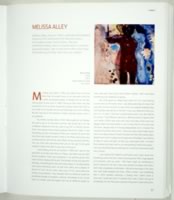


















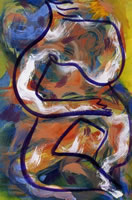
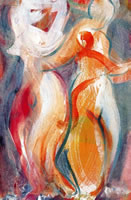










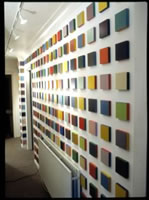
,%202003,%20acrylic%20on%20wood,%20123%20x%2091.5%20cms%20.jpg)


















